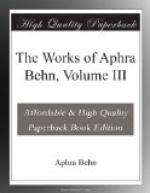P. 201. Alsatia. This cant name had been given to the precinct of Whitefriars before 1623, then and for many years a notorious refuge for persons wishing to avoid bailiffs and creditors. The earliest use of the name is Thomas Towel’s quarto tract, Wheresoever you see meet, Trust unto Yourselfe: or the Mysterie of Lending and Borrowing (1623). The second use in point of time is the Prologue to Settle’s Pastor Fido (1676):—
And when poor Duns, quite
weary, will not stay;
The hopeless Squire’s
into Alsatia driven.
Otway’s comedy, The Soldiers Fortune (4to, 1681), where Courtine says: ‘I shall be ere long as greasy as an Alsatian bully,’ comes third; and Mrs. Behn’s reference to Alsatia in this play, which is often ignored, claims fourth place. We then have Shadwell’s famous comedy, The Squire of Alsatia (1688), with its well-known vocabulary of Alsatian jargon and slang, its scenes in Whitefriars, the locus classicus, a veritable mine of information. The particular portions of Whitefriars forming Alsatia were Ram-Alley, Mitre Court, and a lane called in the local cant Lombard Street. No. 50 of Tempest’s Cries of London (drawn and published in James II’s reign) is called ’A Squire of Alsatia’, and represents a fashionable young gallant. Steele, Tatler (No. 66), 10 September, 1709, speaks of Alsatia ‘now in ruins’. It is interesting to note that many authorities, ignoring Settle and Mrs. Behn’s allusions, quote Powel and Otway as the only two places where the word ‘Alsatia’ is found before Shadwell made it so popular.
p. 202 Dornex. Or dornick, a worsted or woollen fabric used for curtains, hangings and the like, so called from Tournai, where chiefly manufactured. cf. Shadwell’s The Miser (1672), Act i, I: ’a dornock carpet’. Also Wit and Drollery (1681): Penelope to Ulysses:—
The Stools of Dornix
which that you may know well
Are certain stuffs Upholsterers
use to sell.
p. 202 Henry the Eighth. Henry VIII had been put on by Davenant in December, 1663 with a wealth of pomp and expenditure that became long proverbial in the theatrical world. An extra large number of supers were engaged. Downes dilates at quite unusual length upon the magnificence of the new scenery and costumes. The court scene was especially crowded with ’the Lords, the Cardinals, the Bishops, the Doctors, Proctors, Lawyers, Tip-staves.’ On New Year’s Day, 1664, Pepys went to the Duke’s house and saw ‘the so much cried up play of Henry VIII; which tho’ I went with resolution to like it, is so simple a thing, made up of a great many patches, that, besides the shows and processions in it, there is nothing in the world good or well done.’ On 30 December, 1668, however, he saw it again, ’and was mightily pleased, better than ever I expected, with the history and shows of it.’ In The Rehearsal (1671), Act v, I, Bayes says: ’I’l shew you the greatest scene that ever England saw: I mean not for words, for those I do not value; but for state, shew, and magnificence. In fine I’ll justifie it to be as grand to the eye every whit, I gad, as that great Scene in Harry the Eight.’




